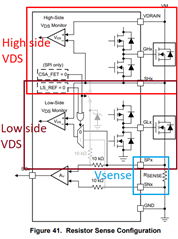Hi Team,
Customer would like to know the difference between VDS protection and VSENSE protection of DRV8323RH. Both of them obtain current by collecting voltage. Are these two functions repeated, or are there other uses?
Thanks,
Annie
This thread has been locked.
If you have a related question, please click the "Ask a related question" button in the top right corner. The newly created question will be automatically linked to this question.
Hi Team,
Customer would like to know the difference between VDS protection and VSENSE protection of DRV8323RH. Both of them obtain current by collecting voltage. Are these two functions repeated, or are there other uses?
Thanks,
Annie
Annie,
In VDS Overcurrent Protection, the device actively compares the voltage across each MOSFET (RDSon * motor current) to a preset threshold voltage (VDS_OCP), and triggers OCP_MODE if the respective voltage drop across the FET exceeds this threshold voltage for a certain amount of deglitch time (tOCP_DEG). Since this is the hardware variant, the tOCP_DEG value is 4 us by default and the VDS_OCP value is configurable through the VDS pin via hardware resistor.
Vsense Overcurrent Protection monitors the voltage drop across an external current sense resistor (Rsense) with the SPx/SNx pins using a different threshold (VSEN_OCP), and the same deglitch time in order to trigger OCP_MODE.
Therefore, these two protection features function in the same way, but have different thresholds, and different locations from which they are measured from. Vsense is measured across the SPx and SNx pins (Rsense * motor current). The following diagram may be helpful to distinguish the location of each measurement on the half-bridge:

Hope this helps,
Johnny